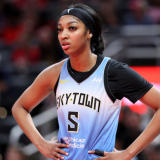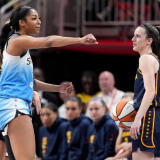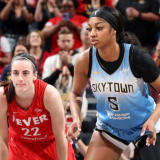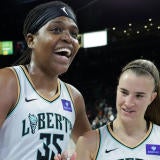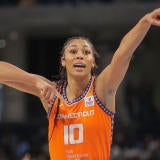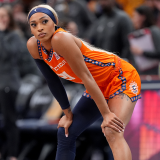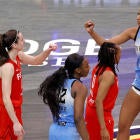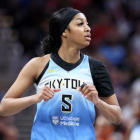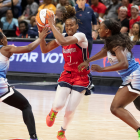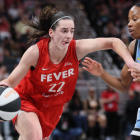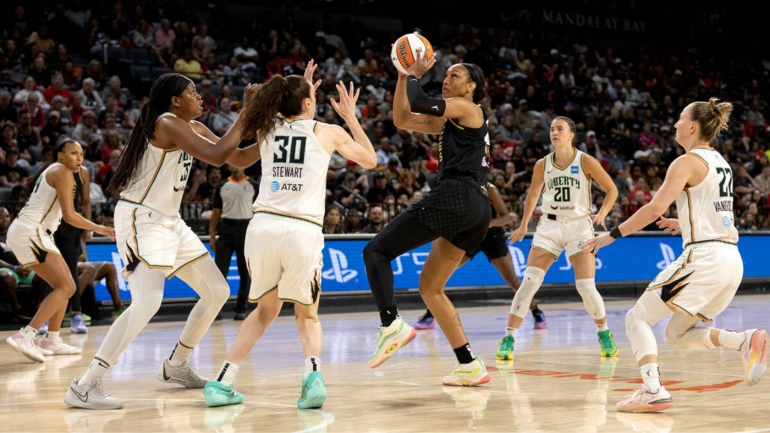
The 2023 WNBA Finals have nearly arrived. On Sunday, the Las Vegas Aces will host the New York Liberty in Game 1 of this long-awaited showdown between the league's two best teams. Before their first postseason meeting, let's go back and look at the final four games they played down the stretch to see what we can learn.
Between Aug. 6 and Aug. 28, the Aces and Liberty played four times, with all of those match-ups coming after Candace Parker sustained a season-ending foot injury. Three of the games were regular season contests and one was the Commissioner's Cup championship. Each team had two games at home. The Liberty went 3-1, outscoring the Aces by 53 points overall, and were the only team to beat the Aces more than once this season.
What does that mean for the Finals, if anything at all? Let's examine why the Liberty had so much success in those games, and how much it matters come Sunday.
The Aces' Kiah Stokes dilemma
When Candace Parker went down with a broken foot in July, there were a lot of questions about how her absence would impact the Aces. Overall, the answer was not much. Kiah Stokes slotted into the starting lineup, and the Aces went 18-4 over the remainder of the regular season, and are 5-0 in the playoffs thus far. In 325 minutes together during the regular season, their current starting lineup with Stokes boasted a +19.1 net rating.
However, Parker's absence was notable against the Liberty. In four games against New York, including the Commissioner's Cup championship, Las Vegas went 1-3, and the new starting lineup was minus-22 in 43 minutes. That's particularly notable because the Aces do not have much depth; if their starters are getting outplayed to that extent, it's tough for them to win.
Here's a perfect example of the problem the Aces have with Stokes in the lineup rather than Parker. Because Stokes is a non-threat on offense, Jonquel Jones is able to roam off her and sinks into the paint to clog up the lane. The Aces run a clever inverted pick-and-roll at the free throw line to get A'ja Wilson going downhill, but there's nowhere for her to go because Jones is already sitting in the paint. Wilson then kicks it to Kelsey Plum, who also tries to drive, but faces the same problem and eventually turns it over.
This is an issue that certainly matters in the Finals. Whether it was with the starters or in different lineup combinations, Stokes' minutes were a huge problem for the Aces. In the four games against the Liberty without Parker, Stokes played 64 minutes, scored zero points and was a minus-47.
The Aces can, and will counter this by going to a small lineup with Alysha Clark at the 4, but that leaves them undersized and the 36-year-old Clark has played more than 25 minutes just seven times all season. It will be interesting to see if Becky Hammon tries to stretch Clark's minutes in the Finals, but either way Stokes is going to have to play in this series, and the Liberty have the matchup advantage when she does.
Paint problems
With Wilson leading the way, the Aces were one of the best interior scoring teams in the league during the regular season. They were the most efficient team in the league around the basket, shooting 69.2% in the restricted area and 49.5% on paint attempts that were not in the restricted area. Both marks led the league, and they also finished third in points in the paint per game (38.4).
Against the Liberty, not so much. Over the four games, the Aces were limited to 32 of 53 (60.4%) in the restricted area, and 29 of 67 (43.3%) on non-restricted area shots in the paint. Both marks were well below their season averages.
Why?
For starters, the Liberty have two of the best, most versatile interior defenders in the league in Breanna Stewart and Jones. While the Liberty may have some holes on the perimeter, it's not easy to finish when you get inside and have to deal with the size, length and athleticism of that star duo. During the regular season, the Liberty allowed opponents to shoot just 57.9% in the restricted area, which was the second-best mark in the league.
So regardless of what else is going on, you have to contend with two All-Defensive candidates at the rim. Then, complicating matters for the Aces is the Stokes situation. The Liberty are willing to ignore her to send extra bodies to the paint. Just watch on this play, as Wilson tries to turn the corner on Stewart, but sees Jones, who has left Stokes, waiting in the paint. Unable to get to the rim, Wilson has to settle for a fadeaway over both Stewart and Jones, and misses.
If Stokes is in the game, this is the sight that will await the Aces in the lane. While the Liberty showed a willingness to help off Clark, especially to send bodies to Wilson, this is a far riskier proposition.
Specifically in regards to Wilson, it was noticeable that in the final regular season game between the teams, the Aces made an effort to get her the ball away from the basket to make it more difficult for the Liberty to send help. Wilson had a great game, finishing with 23 points on 10 of 16 from the field, but look at her shot chart. The majority of her attempts were from mid-range, and while she can score from there, the Liberty will gladly take those over shots at the basket.
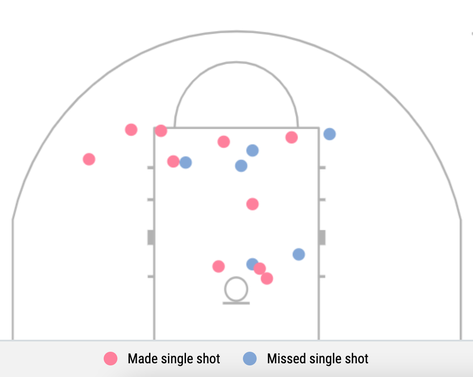
The Liberty's ability to protect the basket will matter a great deal in determining this season's champion. We saw them have problems keeping the Sun out of the paint in the semifinals, so much so that they had to switch to a zone at times -- something that won't be as easy to pull off against a better shooting Aces team. Will the Liberty's guards be able to hold their own on the perimeter? If so, the help behind them will make life difficult for the Aces.
Second-chance points
One of the areas that the Liberty were significantly better than the Aces this season, both overall and in their four final matchups, was on the offensive glass. Led by Jones and Stewart, the Liberty boasted a 30.8 offensive rebound rate, which was good for third in the league; the Aces, meanwhile, finished dead last in that category at 23.7.
Over the four games these rivals played down the stretch, the Liberty grabbed 39 offensive rebounds, which they turned into 50 second-chance points, compared to 18 offensive boards and 31 second-chance points for the Aces. It wasn't a case of poor shooting leading to more opportunities on the glass either, as the Liberty shot better than the Aces in those four games, yet still had more offensive rebounds overall.
As noted, one of the dilemmas in this series for the Aces is what to do about the fifth spot in the lineup. Stokes makes it hard for them on offense, but Clark leaves them undersized. To that point, it's worth noting that 23 of the Liberty's offensive rebounds in those four matchups came against the small lineup and 16 of them came against the big lineup. While it's clear the Liberty will take advantage on the glass if the Aces go small, they're going to do so regardless.
Does this matter for the Finals? Absolutely. Rebounding is one of the four factors of basketball for a reason. It is worth noting, though, that the Aces have shown they can contain the Liberty on the glass. In the one game the Aces won of the previous four meetings, they out-rebounded the Liberty 35-28, and held them to just four offensive boards. If the Aces can just keep the rebounding battle fairly even, if will go a long way towards repeating.
3-point shooting
The Liberty led the league in both 3-point attempts and percentage this season, and while the Aces were second in both categories, they really weren't close to matching the Liberty's historic effort from behind the arc. The Liberty's 29.7 attempts per game were the most all-time, and they also set records for makes per game (11.1) and total makes (444), while shooting 37.4%. By comparison, the Aces made 371 three-pointers on 37.2% shooting this season.
During the four key meetings between these teams, it was a similar story. The Liberty took far more 3s and made far more 3s, shooting 57 of 145 (39.3%) compared to the Aces' 29 of 97 (29.9%). New York's 84-point advantage from downtown was a major factor in their 3-1 record in those games.
The main reason the Liberty are so difficult to guard on the perimeter is because every player they put on the floor can knock down a shot and every player can command multiple defenders. That's going to put the defense in tough situations. Let's take these two examples in tandem:
First, we have Sabrina Ionescu and Stewart running the floor in transition. Stewart slips out of it, but Clark has to stay for a split second to protect the lane. That gives Stewart time to set her feet, and she buries the pick-and-pop triple off the feed from Ionescu.
Now here's a different possession where the roles are reversed: The Liberty post up Betnijah Laney, then run Stewart off an off-ball screen, which turns into a hand-off from Laney. Moving with a head of steam, Stewart powers into the lane, draws multiple defenders and whips a lefty hook pass out to Ionescu, who had floated free on the line. She knocks down the open look with ease.
There you have your point guard and power forward trading roles in freeing each other up for 3-pointers. No other team has that sort of line-up flexibility, and it's extremely difficult to guard when the Liberty get rolling.
So does this matter? Yes, because 3-point shooting is the key to any series. However, the regular season numbers are not necessarily predictive of how the Finals will go. The Aces created plenty of open 3s of their own over those four games and were unlucky to shoot such a poor percentage. While the Liberty are going to take more 3s, the Aces have the ability to out-shoot them, especially over the course of five games.







